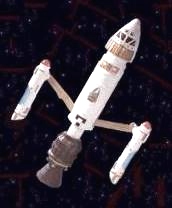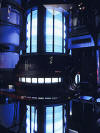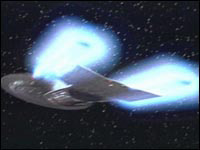YOU ARE ACCESSING THE LCARS COMMAND INTERFACE - TECHNICAL DATABANK
Warp Propulsion
The discoverer of the space warp. Zefram Cochrane became one of Earth's history's most renowned propulsion scientist when he revolutionized space travel in 2063 with his invention of the warp drive, making faster-than-light travel possible. Cochrane worked with an close engineer friend named Lily Sloane, in constructing his warp ship, the Phoenix, in an abandoned missile complex in central Montana on the North American continent.

Ironically, the booster stage of the Phoenix was originally built as a nuclear weapon of mass destruction. Despite interference from a Borg attack from the future, Cochrane conducted the first warp flight on April 4, 2063.








That historic flight was detected by a passing Vulcan ship, and was therefore directly responsible for humanity's first contact with the interstellar community on the following day. Cochrane's motivation for building the Phoenix had been purely commercial, and he was uncomfortable with the fame and adulation that was subsequently his, but he later realized that it was his individuality that made this extraordinary achievement possible.
Phoenix Ship Status Display
A decade after his historic flight, Cochrane said "Don't try to be a great man, just be a man, and let history make its own judgments." In later years, Cochrane's name became revered throughout the known galaxy; planets, great universities, and cities were later named after him. Zefram Cochrane disappeared from Alpha Centauri in 2117 at the age of 87 and is presumed to have died in space. The area of Montana that was once the Phoenix's launch facility became a historical monument. A 20-meter marble statue was erected there, showing Cochrane reaching toward the future.






A starship's Warp Propulsion System (WPS) consists of three major assemblies.
First, the matter/anti-matter reaction assembly (M/ARA) generates power from a controlled annihilation of matter and antimatter.
Second, the power transfer conduits carry the energy plasma from the reaction chamber to the warp engine nacelles; at this point, power to run the bulk of the ship's non-propulsive systems is accessed by electro plasma system (EPS) taps.
Finally the plasma is directed to the warp engine nacelles, where it is used to create the subspace mechanics necessary for faster-than-light travel.

To Test out Warp calculations click here to go to Warp Calculator.

While a Starship carries "traditional" fusion reactor fuel as well, the bulk of a ships systems depends upon the WPS for their operation.
The subspace field necessary to propel a Starship across vast interstellar distances is created by a combination of the specific configuration of the Starship hull and the warp field coils located in the two warp drive nacelles.

These coils generate an intense, multilayered field surrounding the ship, and it is the manipulation of this field that produces a propulsive effect.
Each nacelle contains a number of warp field coils; when energized, the coils cause an energy shift that actually changes the geometry of space around the Starship.
When the coils are fired sequentially, they create warp field layers that press upon each other and cumulatively reduce the apparent mass of the vehicle, allowing the ship to move faster than the speed of light.



Last edited by Adge - July 2004

The discoverer of the space warp. Zefram Cochrane became one of Earth's history's most renowned propulsion scientist when he revolutionized space travel in 2063 with his invention of the warp drive, making faster-than-light travel possible. Cochrane worked with an close engineer friend named Lily Sloane, in constructing his warp ship, the Phoenix, in an abandoned missile complex in central Montana on the North American continent.

Ironically, the booster stage of the Phoenix was originally built as a nuclear weapon of mass destruction. Despite interference from a Borg attack from the future, Cochrane conducted the first warp flight on April 4, 2063.








That historic flight was detected by a passing Vulcan ship, and was therefore directly responsible for humanity's first contact with the interstellar community on the following day. Cochrane's motivation for building the Phoenix had been purely commercial, and he was uncomfortable with the fame and adulation that was subsequently his, but he later realized that it was his individuality that made this extraordinary achievement possible.
Phoenix Ship Status Display
A decade after his historic flight, Cochrane said "Don't try to be a great man, just be a man, and let history make its own judgments." In later years, Cochrane's name became revered throughout the known galaxy; planets, great universities, and cities were later named after him. Zefram Cochrane disappeared from Alpha Centauri in 2117 at the age of 87 and is presumed to have died in space. The area of Montana that was once the Phoenix's launch facility became a historical monument. A 20-meter marble statue was erected there, showing Cochrane reaching toward the future.






A starship's Warp Propulsion System (WPS) consists of three major assemblies.
First, the matter/anti-matter reaction assembly (M/ARA) generates power from a controlled annihilation of matter and antimatter.
Second, the power transfer conduits carry the energy plasma from the reaction chamber to the warp engine nacelles; at this point, power to run the bulk of the ship's non-propulsive systems is accessed by electro plasma system (EPS) taps.
Finally the plasma is directed to the warp engine nacelles, where it is used to create the subspace mechanics necessary for faster-than-light travel.

To Test out Warp calculations click here to go to Warp Calculator.

While a Starship carries "traditional" fusion reactor fuel as well, the bulk of a ships systems depends upon the WPS for their operation.
The subspace field necessary to propel a Starship across vast interstellar distances is created by a combination of the specific configuration of the Starship hull and the warp field coils located in the two warp drive nacelles.

These coils generate an intense, multilayered field surrounding the ship, and it is the manipulation of this field that produces a propulsive effect.
Each nacelle contains a number of warp field coils; when energized, the coils cause an energy shift that actually changes the geometry of space around the Starship.
When the coils are fired sequentially, they create warp field layers that press upon each other and cumulatively reduce the apparent mass of the vehicle, allowing the ship to move faster than the speed of light.


Last edited by Adge - July 2004